Cancer care
This section presents data for the cancer care indicators supplied for Australia to the OECD HCQO collection. It compares these data with the HCQO results reported for other OECD countries, and comments on the comparability of the data provided to the OECD specification (OECD 2021).
The OECD published all cancer care indicators in OECD.Stat and a selection of cancer care indicators in Health at a glance 2021. Data for Australia were available for all 7 cancer care indicators:
- Breast cancer 5-year net survival
- Cervical cancer 5-year net survival
- Colon cancer 5-year net survival
- Rectal cancer 5-year net survival
- Childhood acute lymphoblastic leukaemia 5-year net survival
- Lung cancer 5-year net survival
- Stomach cancer 5-year net survival.
A person’s chance of surviving cancer depends on many factors, including their lifestyle and health conditions, the type of cancer they have, how far it had progressed before being diagnosed, and what kinds of treatment are available. For some cancers, survival for 5 years after diagnosis is an important indicator of successful cancer management, although for others there is still a substantial chance that the cancer may recur (AIHW 2012).
Net survival rates are cited within this section; these rates adjust for differences that occur between populations and they improve the comparability of cancer survival rates between populations with different characteristics such as age distribution and risk from dying from causes other than cancer.
The indicator definitions can be viewed here: Cancer care indicator definitions
Overall data comparability and methods
The most recent data relating to Australia for the cancer care indicators were for the period 2010–14. These data were provided to the OECD by CONCORD, an international collaboration designed to monitor trends in cancer survival worldwide (Allemani et al. 2018). Data for the same period (2010–14) from other OECD countries published on OECD.Stat are used for comparison and calculation of OECD averages in this section. These data were extracted from the OECD.Stat database in November 2021, and may not reflect subsequent updates made to the database.
Five-year net survival is the cumulative probability that cancer patients survive their cancer for at least five years after diagnosis, after controlling for the risks of death from other causes, and taking into account that competing risks of deaths are higher in older people (OECD 2021). The net survival rates were age-standardised using the appropriate populations from the International Cancer Survival Standards (OECD 2021).
Breast cancer 5-year net survival rate
The five-year net survival in Australia for females aged 15 and over diagnosed with breast cancer was 89.5% for the period 2010–14, showing a 2.5 percentage-point improvement since 2000–04.
Australia had the second highest 5-year net survival from breast cancer among OECD countries that submitted data, behind the United States (90%). The OECD average was 84%.
The early detection of cancer is important for improving the chance of survival. In Australia, the five-year net survival rate after a breast cancer diagnosis in its earliest stage was 100% in 2011 (AIHW 2019). For females diagnosed with breast cancer at the latest stage, the survival rate reduced to 32% (AIHW 2019).
Interactive CC1.1 below compares OECD countries with data available for this indicator in 2010–14, while CC1.2 presents Australia’s rate over time (post-2000) for this indicator where data were available.
CC1.1 presents OECD countries with data available for breast cancer 5-year net survival rate in 2010–14, which shows Australia had the 2nd highest survival rate. CC1.2 presents Australia’s 10-year trend for this indicator, which shows a gradual increase over time.
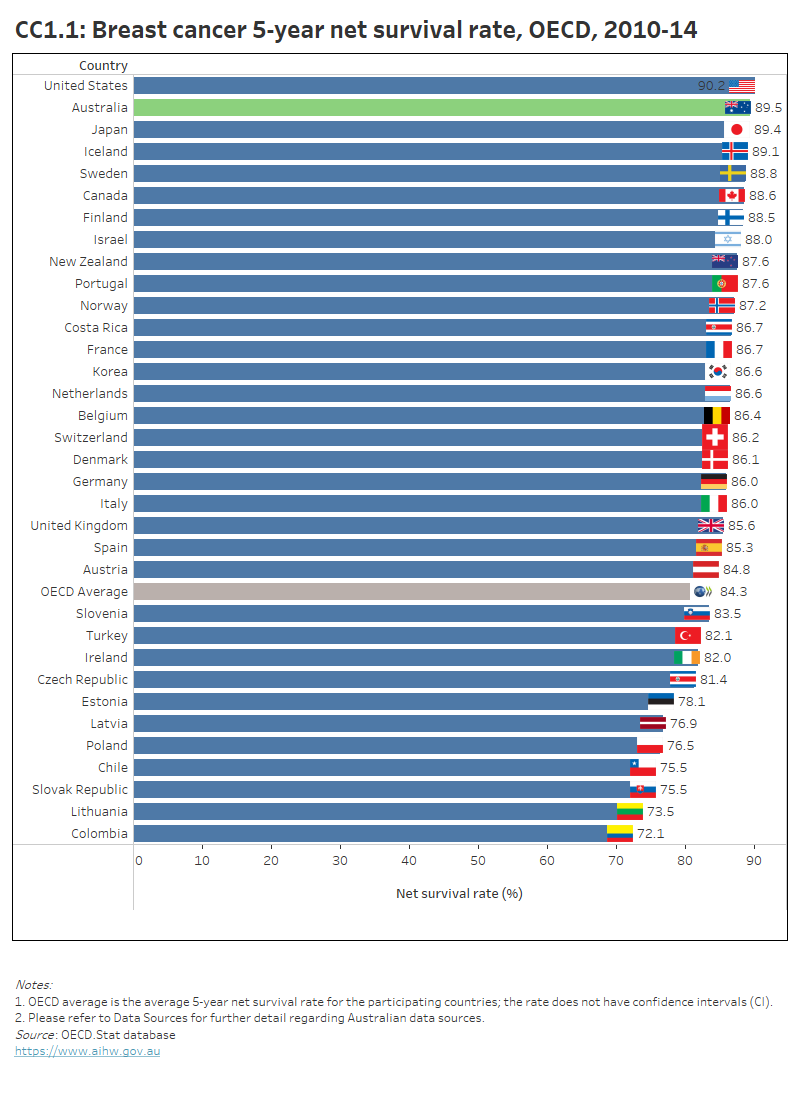
Refer to the data tables for more information.
Cervical cancer 5-year net survival rate
The cervical cancer five-year net survival in Australia for females aged 15 and over was 66% for the period 2010–14, a decrease from 68% in the period 2000-04.
Australia’s 5-year net survival from cervical cancer was similar to the OECD average (65.5%) for the comparison period. Among OECD countries with data available, Iceland (80%) had the highest survival rate from cervical cancer.
Interactive CC2.1 below compares OECD countries with data available for this indicator in 2010–14, while CC2.2 presents Australia’s rate over time (post-2000) for this indicator where data were available.
CC2.1 presents OECD countries with data available for cervical cancer 5-year net survival rate in 2010–14, which shows Australia had the same survival rate as the OECD average. CC2.2 presents Australia’s 10-year trend for this indicator, which shows a gradual decrease over time.
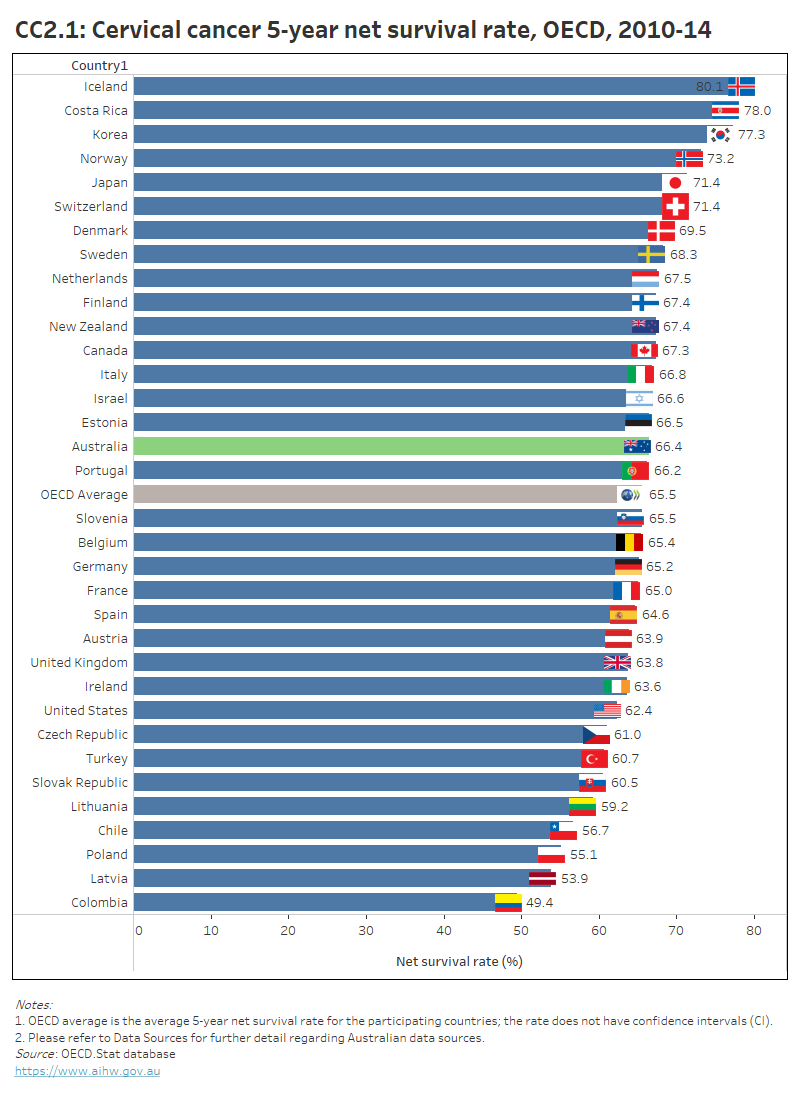
Refer to the data tables for more information.
Colon cancer 5-year net survival rate
The five-year net survival rate for colon cancer among people aged 15 and over in Australia was 71% for the period 2010–14, showing a 7 percentage-point improvement since 2000–04. The survival rates for both males (70%) and females (72%) have also experienced a 7 percentage-point improvement since 2000–04. The OECD average was 61%.
Australia’s colon cancer survival rate was slightly below that of Korea and Israel, the countries with the highest survival rates (both 72%).
Interactive CC3.1 below compares OECD countries with data available for this indicator in 2010–14, while CC3.2 presents Australia’s rate over time (post-2000) for this indicator where data were available.
CC3.1 presents OECD countries with data available for colon cancer 5-year net survival rate in 2010–14, which shows Australia had one of the highest survival rates. CC3.2 presents Australia’s 10-year trend for this indicator, which shows a gradual increase over time.
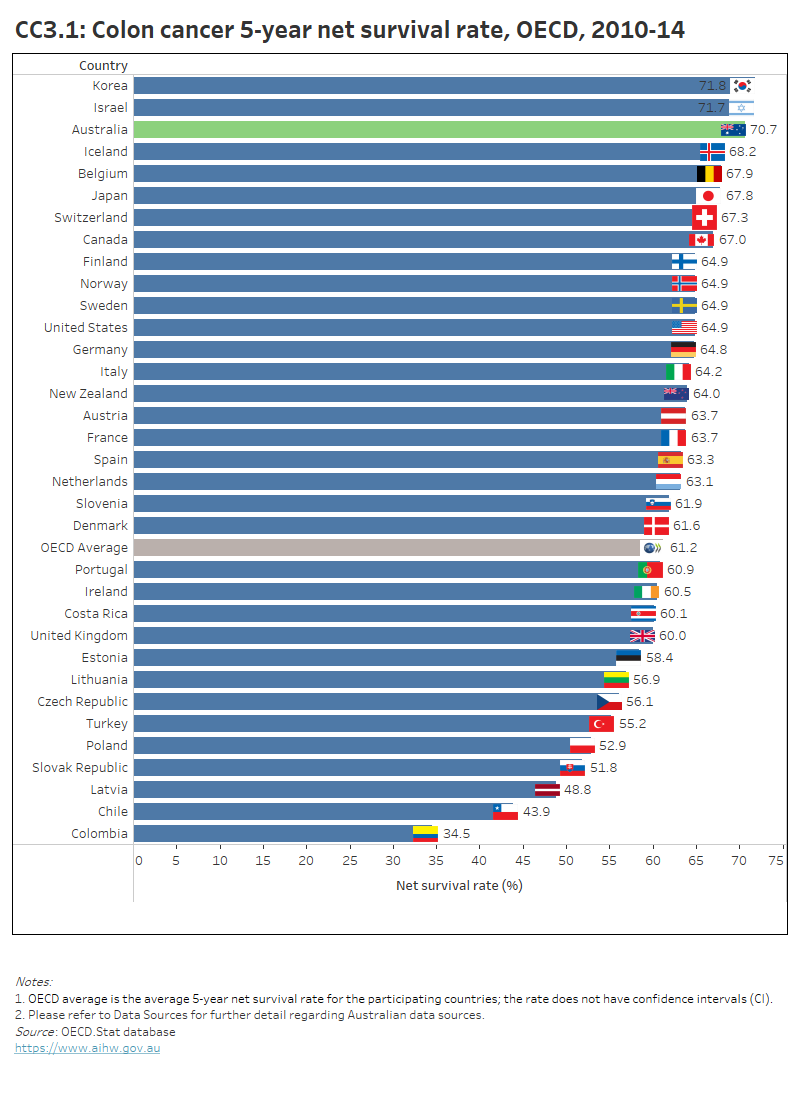
Refer to the data tables for more information.
Rectal cancer 5-year net survival rate
The five-year net survival rate for rectal cancer among people aged 15 and over in Australia was 71% for the period 2010–14, showing a 7 percentage-point improvement since 2000–04. The survival rates for both males (70%) and females (74%) also experienced a 7 percentage-point improvement since 2000–04.
Korea and Australia had the highest rectal cancer survival rates (71%) among countries that submitted data. The OECD average was 60%.
Interactive CC4.1 below compares OECD countries with data available for this indicator in 2010–14, while CC4.2 presents Australia’s rate over time (post-2000) for this indicator where data were available.
CC4.1 presents OECD countries with data available for rectal cancer 5-year net survival rate in 2010–14, which shows Australia and Korea had the highest rates. CC4.2 presents Australia’s 10-year trend for this indicator, which shows a gradual increase over time.
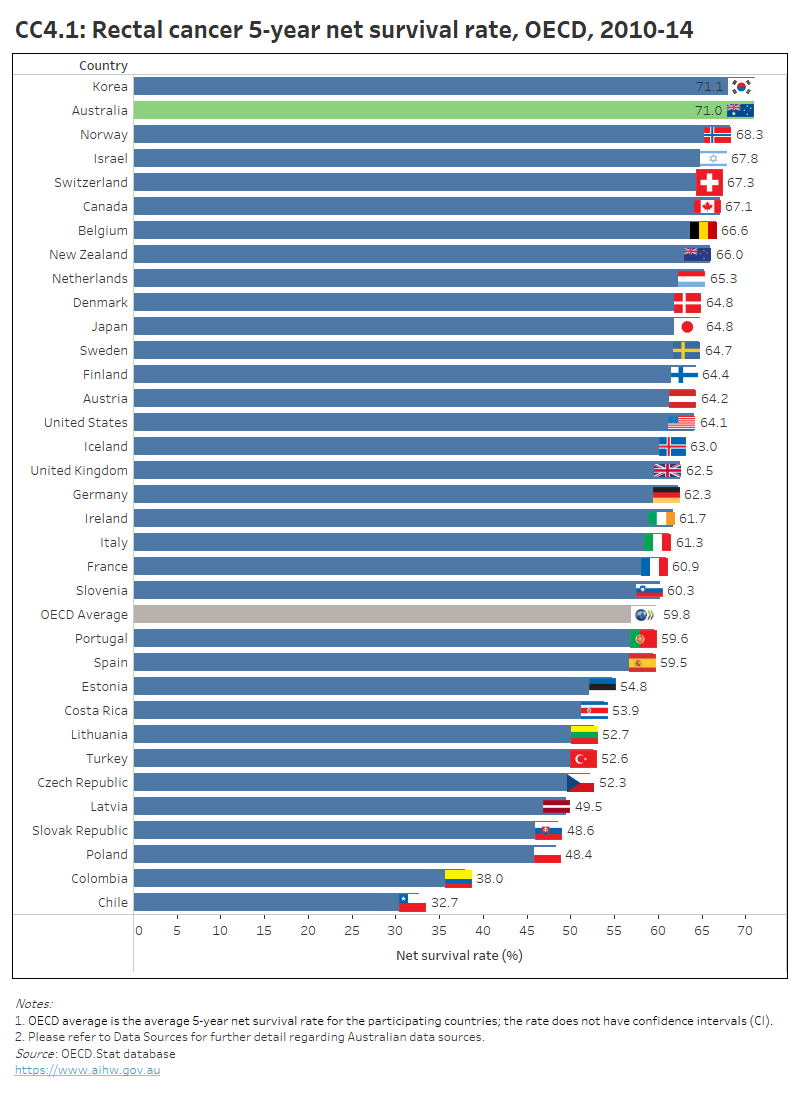
Refer to the data tables for more information.
Childhood acute lymphoblastic leukaemia 5-year net survival rate
The acute lymphoblastic leukaemia five-year net survival in Australia for children aged 0 to 14 was 91% for the period 2010–14, maintaining a similar rate since 2000–04.
Australia’s 5-year net survival from childhood acute lymphoblastic leukaemia was higher than the OECD average of 86%. Finland (95%), Denmark (94%), Canada (93%) and the United Kingdom (92%) had the highest survival rates.
Interactive CC5.1 below compares OECD countries with data available for this indicator in 2010–14, while CC5.2 presents Australia’s rate over time (post-2000) for this indicator where data were available.
CC5.1 presents OECD countries with data available for childhood acute lymphoblastic leukaemia 5-year net survival rate in 2010–14, which shows Australia had a higher survival rate than the OECD average. CC5.2 presents Australia’s 10-year trend for this indicator, which shows a gradual increase over time.
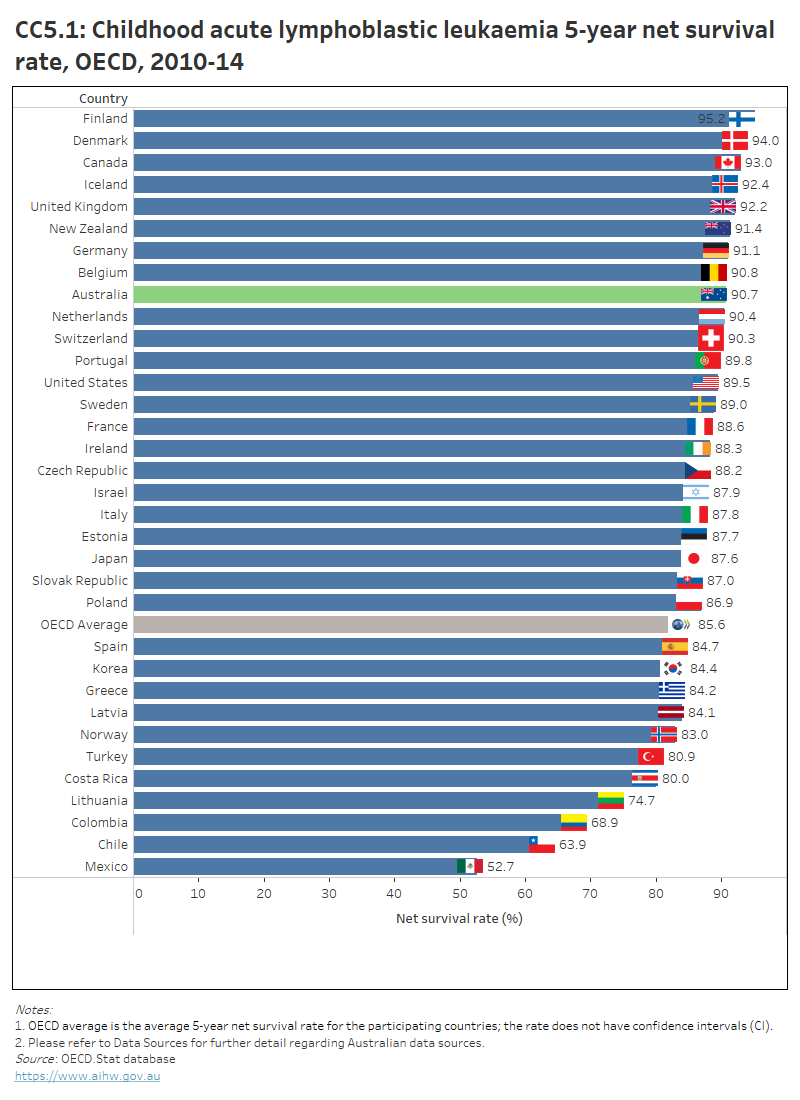
Refer to the data tables for more information.
Lung cancer 5-year net survival rate
The five-year net survival rate for lung cancer among people aged 15 and over in Australia was 19% for the period 2010–14, showing a 4 percentage-point improvement since 2000–04. The survival rates for males (17%) and females (22%) experienced a 4 percentage-point and 5 percentage-point improvement respectively since 2000–04.
Australia’s 5-year net survival from lung cancer was higher than the OECD average of 17% for the comparison period. Among OECD countries with data available, Japan (33%) had the highest survival rate.
Interactive CC6.1 below compares OECD countries with data published for this indicator in 2010–14, while CC6.2 presents Australia’s rate over time (post-2000) for this indicator where data were available.
CC6.1 presents OECD countries with data published for lung cancer 5-year net survival rate in 2010–14, which shows Australia had a higher survival rate than the OECD average. CC6.2 presents Australia’s 10-year trend for this indicator, which shows a gradual increase over time.
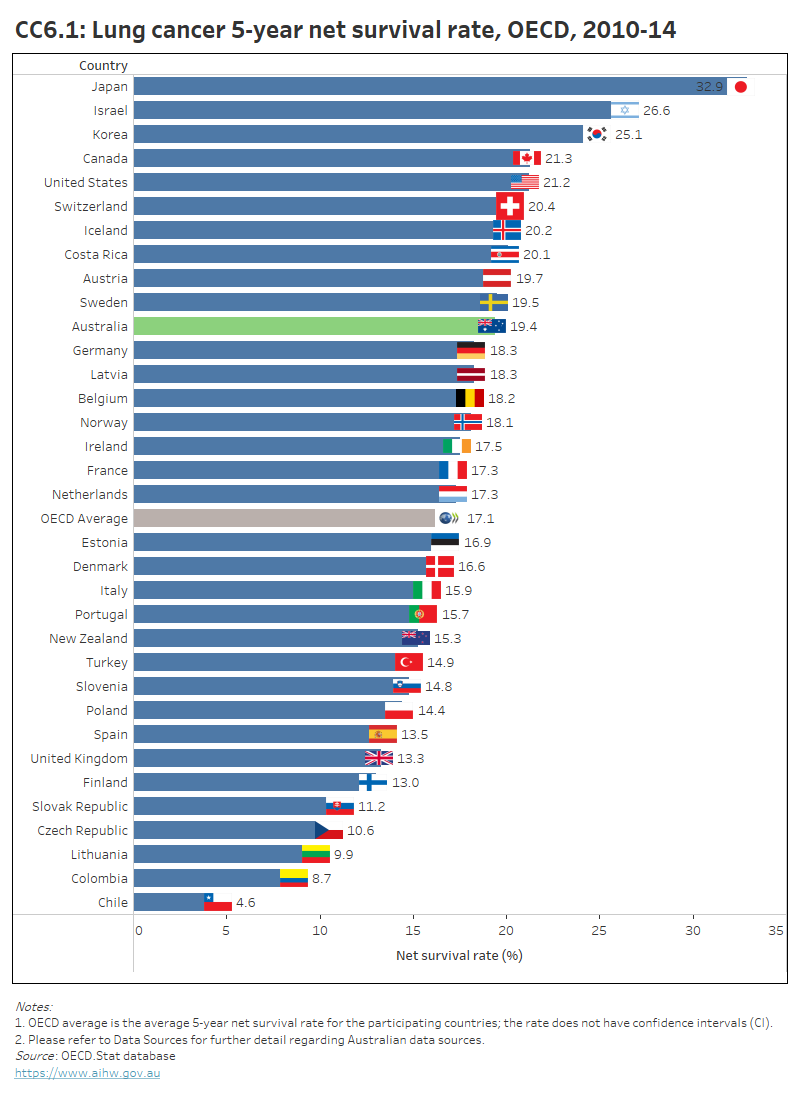
Refer to the data tables for more information.
Stomach cancer 5-year net survival rate
The five-year net survival rate for stomach cancer among people aged 15 and over in Australia was 32% for the period 2010–14, showing a 4 percentage-point improvement since 2000–04. The survival rates for males (30%) and females (36%) experienced a 3 percentage-point and 7 percentage-point improvement respectively since 2000–04.
Australia’s 5-year net survival from stomach cancer was higher than the OECD average of 30% for the comparison period. Among OECD countries with data available, Korea (69%) and Japan (60%) had the highest survival rates.
Interactive CC7.1 below compares OECD countries with data published for this indicator in 2010–14, while CC7.2 presents Australia’s rate over time (post-2000) for this indicator where data were available.
CC7.1 presents OECD countries with data published for stomach cancer 5-year net survival rate in 2010–14, which shows Australia had a higher survival rate than the OECD average. CC7.2 presents Australia’s 10-year trend for this indicator, which shows a gradual increase over time.
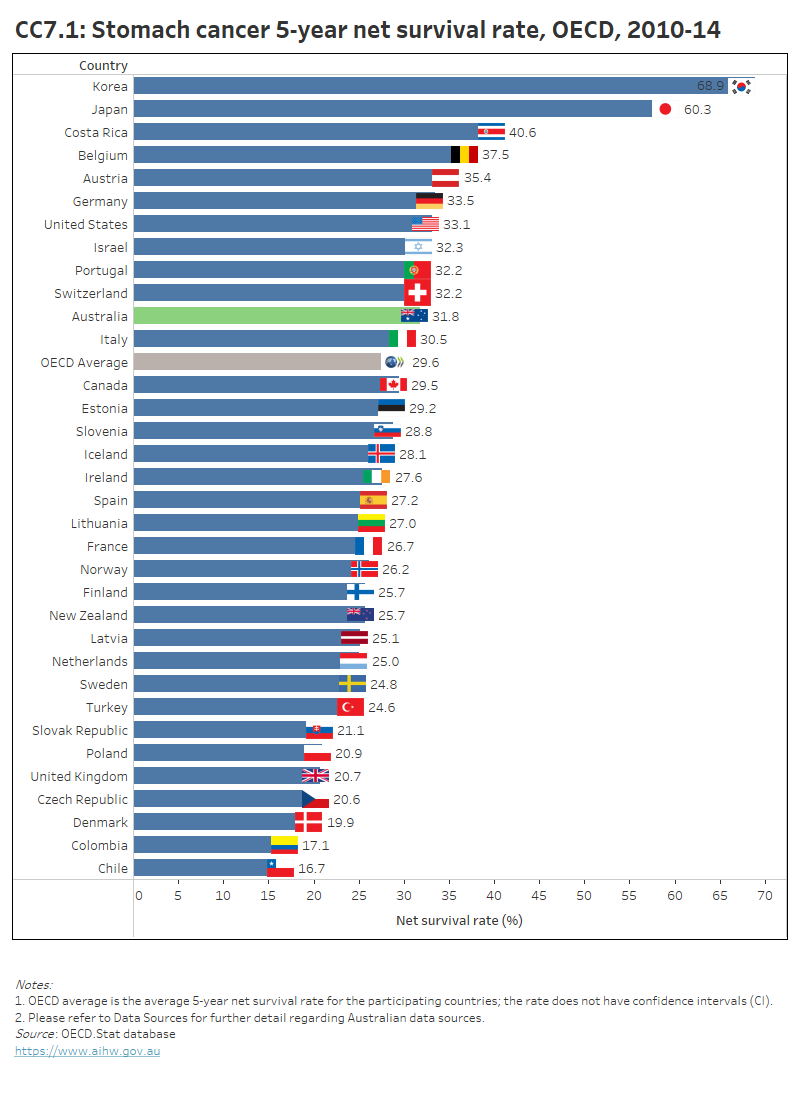
Refer to the data tables for more information.
AIHW 2012. Cancer survival and prevalence in Australia: period estimates from 1982 to 2010. Cancer series no. 69. Cat. no. CAN 65. Canberra: AIHW.
AIHW 2019. Cancer in Australia 2019. Cancer series no. 119. Cat. no. CAN 123. Canberra: AIHW.
Allemani C, Matsuda T, Di Carlo V et al. 2018. Global surveillance of trends in cancer survival 2000–14 (CONCORD-3): analysis of individual records for 37,513,025 patients diagnosed with one of 18 cancers from 322 population-based registries in 71 countries. The Lancet 391(10125):1023–1075.
OECD 2021. Health at a glance 2021: OECD indicators. Paris: OECD.


